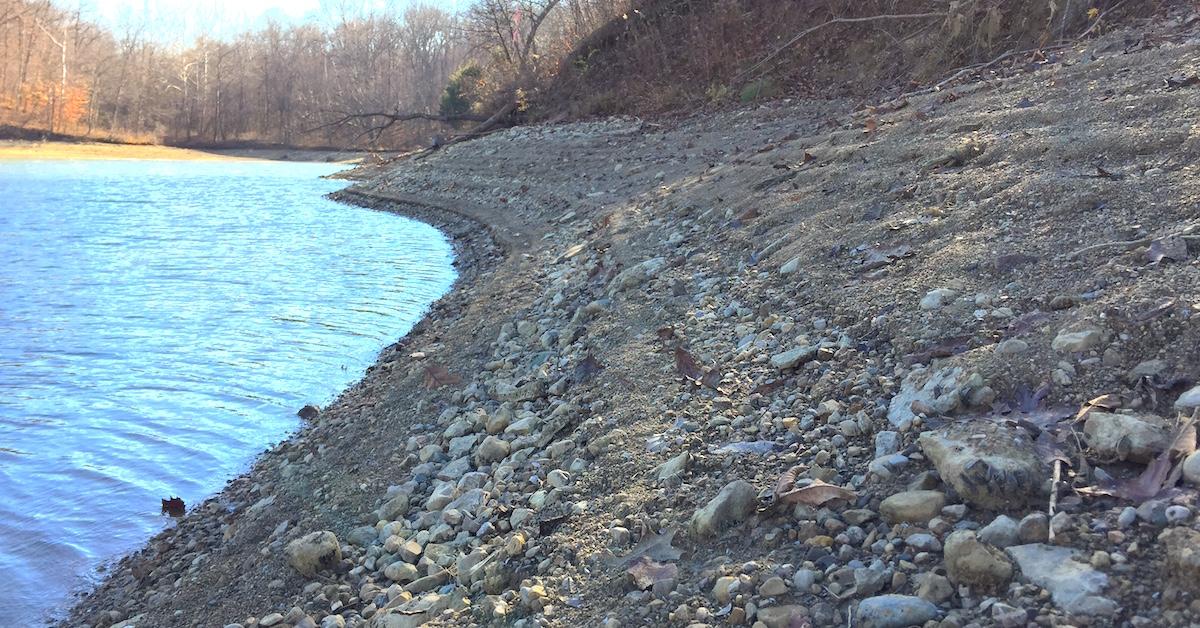5 Types Of Bottom Composition And How To Fish Them
There have been an almost infinite number of articles written about how bass relate to various types of structure and cover. The same can be said for other classic patterns like skipping docks and working grass lines.An equally important factor that has gone woefully undiscussed is bottom composition. An intimate knowledge of common types of bottom substrate and how (and when) bass relate to them will not only result in more catches, but also the ability to better predict bass’ future movements between their spawning cycle and the annual seasons.Here’s a breakdown of 5 common bottom composition types and how to catch bass off them.
1. Rocks
When Are Bass There?
Rocks are attractive to bass throughout the year, but they are absolutely critical in the pre-spawn. Rocks hold heat early and harbor crayfish, which are two necessities for pre-spawn bass as they feed up in the early season.
Where To Look?
Rocks abound in many natural lakes, reservoirs and rivers. Rip rap and chunk rock is usually found on the bank, and rocks are also found on offshore structure like river ledges, humps, and points.
How To Fish?
The best bets for rocks are anything that imitates a crayfish. Slow moving baits like football jigs, Carolina rigged worms, and tubes are great choices, as are moving baits like square bills and chatterbaits.
2. Sand
When Are Bass There?
Sand is one of the most overlooked substrates found in most places, as anglers assume its lack of hiding spots prevents bass from using it. The reality though is that bass absolutely use sand, particularly in the fall. On river systems, huge schools of smallmouth cruise sand drops waiting to ambush schools of shad.
Where To Look?
On river systems, current creates sand drops that offer excellent places for bass looking to hide out of the current. Look for sand drops at the bottom ends of running sloughs, along main-channel islands, and behind wing dams. Aerial photography websites like google earth are great for finding sand drops, as they are often easily viewable.
How To Fish?
The best bets for fishing sand are shad imitating baits that can be fished fast, like lipless crankbaits, soft jerkbaits, and walk-the-dog topwaters.
3. Muck
When Are Bass There?
In shallow, weedy lakes, muck is one of the first things bass pull up onto when the water starts to warm in the spring. Muck is dark in color, so it absorbs the sun’s rays and heats the water. Early season bass roam shallow, mucky areas looking for easy meals of bluegill.
Where To Look?
Muck bottom is most commonly found in the backs of pockets, in shallow bays, and around marshy wetland drains. Muck is particularly effective in lowland reservoirs and tidal fisheries.
How To Fish?
Since bass using mucky areas are generally feeding on bluegill, presentations like swimming jigs, and Texas rigged plastics are excellent choices.
4. Gravel
When Are Bass There?
When bass start spawning, gravel is one of the most common substrates they choose to fan out their nests on. Gravel offers a hard but easily malleable bottom with plenty of surface area for their eggs to rest without being exposed to predators.
Where To Look?
Gravel can be found almost anywhere on a lake, but bass often look for gravel in protected areas like marinas, main-lake pockets, and on shallow weedy flats.
How To Fish?
When bed fishing, there’s not much more effective than a classic Texas rigged worm. Other good bets on gravel include search baits like spinnerbaits, jerkbaits, and swimbaits.
5. Shells
When Are Bass There?
You’ll often hear anglers on the famed Tennessee River reservoirs talk about the big stringers of bass they pull from offshore shell beds in the summer. Shell beds offer a rough bottom that attracts numbers of bottom fish like sculpin and darters. Mussels also thrive in places that feature current, which bass relate to when waiting for schools of pelagic shad to swim by.
Where To Look?
Shell beds are most commonly found in or near the old river channel in reservoirs, and on bars and humps near current. Shells are often visible with todays high-powered electronics, but another good way to find them is to drag a heavy Carolina rig through an area, and feel for the tell-tale bumps that occur as the weight rolls over the shells.
How To Fish?
Classic ledge fishing presentations like crankbaits, swimbaits, football jigs, and Carolina rigged worms are ideal for pulling offshore bass from shell beds.
Updated February 8th, 2019 at 3:38 AM CT


